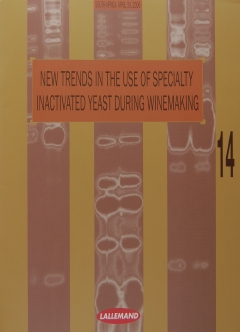New Trends in the use of Speciality Inactivated Yeast during Winemaking
| Auteur(s) auteurs | Colloque Lallemand N°14 - Afrique du Sud - 2006 |
|---|---|
| Nb pages nb_pages | 38 |
| Année d'édition anneedition | 2006 |
| Langue(s) langues | N/A |
| Autres versions disponibles versions_disponibles | Aucune |
| Récompenses recompenses | Non |
| Franco France price | 35,00 € |
| Franco tous pays price_expo | 40,00 € |

FOREWORD
The world of wine is in constant evolution, and new research is being conducted on a variety of innovative tools, such as specialty inactivated yeast (SIY) products and their contributions to wine. SIY products were the focus of the XVIIIes Entretiens Scientifiques Lallemand held April 30, 2006, at the Kwa Maritane Lodge in South Africa. The program for these technical meetings included presentations reporting on current knowledge regarding the composition of yeast and its derivatives and their commercial equivalent - SIY products.
From current knowledge on the cell walls of yeast, which vary in composition according to the conditions in their environment (the cell walls redesign themselves to adapt to their environment), to the research on yeast hulls and their environment), to the research on yeast hulls and their utilization in winemaking, the presentations were both applied and scientific. The importance of mannoproteins and peptides are released during aging, subsequent to autolysis, influencing the structure and sensory properties of the wine. This is a long process. To obtain wines with a richer sensory rofile, the winemaker can accelerate the process by using selected yeast strains that produce large quantities of mannoproteins or yeast extracts high in mannoproteins or glutathione (to prevent oxidation). The practical experience on the subject of mannoproteins and oenological products high in Saccharomyces cerevisiae cell walls was also discussed. Aging on fine lees and the different factor that can help the winemaker, e.g., the quality of the grapes, the yeast strain, enzyme, maceration and the management of malolactic fermentation, were presented.
The results of the presenters' research show that the claims for SIY products are scientifically based. The oenological world is in the early stages of research into these new techniques that are already being used in wineries. By understanding the various impacts of SIY products based on the cell walls of different yeast strains, Lallemand hopes to have new products and better inform winemakers, thereby contributing to the making of quality wines.
CONTENTS
- The cell wall of the yeast Saccharomyces cerevisiae: an investigation of dynamic complexity for the better utilization of its biotechnological values
(Jean-Marie François) - Oenological impact of mannoproteins and peptides from yeast: examples of interaction with wine polyphenols
(Michel Feuillat) - Yeast walls: a promising future ?
(Hervé Alexandre, Michèle Guilloux-Benatier, David Chassagne) - Mannoproteins and aromatic compounds in wine
(Daniel Granès) - The Management of lees
(Daniel Granès) - Effects of inactivated dry yeast in fermentation
(Daniel Granès)
